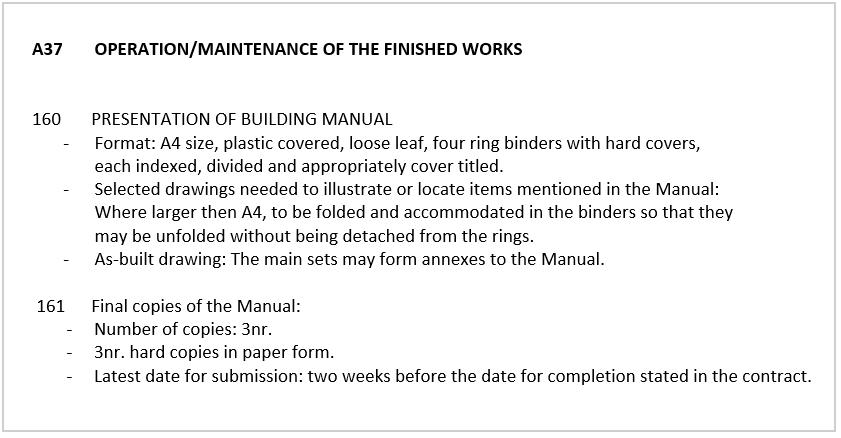Why hard copies of O&M manuals are obsolete
Contents |
[edit] Introduction
The building owner's manual, or operation and maintenance manual (O&M manual), contains the information required for the operation, maintenance, decommissioning and demolition of a building.
So, how many hard copies do you need?
The answer is none. In 2017, there are much more effective methods of delivery for structured data and O&M requirements.
Multiple hard copies are often a contractual requirement but this does not mean they shouldn’t be challenged. Here’s a typical example of the standard A37 specification within the Employers Information Requirements [EIRs]:
However, generally, when a client is informed of the problems associated with paper copies and the direct cost saving available by reducing them, it is often possible to eliminate hard copies entirely.
[edit] The problem with hard copies
Once a hard copy is delivered, it is rarely looked at and provides limited benefit to the end user.
Common problems associated with hard copy O&Ms:
- They are costly to produce.
- They quick to become out of date.
- They have significant storage requirements.
- They are susceptible to loss and damage.
- It can be difficult to locate information
[edit] Benefits of paperless alternatives
Delivering project data through the cloud has numerous benefits for the end user over traditional paper methods:
- Cost savings
- They are simple to navigate.
- Data is secure and backed up.
- They can be accessed anywhere at anytime.
- The ability to integrate with client systems.
[edit] Why not invest in hosting instead?
The cost saving from eliminating hard copies can be invested in services that may be more beneficial to end users such a hosting agreement, which provides:
- 24/7 access to real project data.
- Updates for future fit-out and alterations.
- On-going training and support for end users.
[edit] Or an enhanced asset register & PPM schedule
Often, when a building manager takes occupation, the first thing they do is procure an expensive manual survey to identify what plant they have inherited. This is because key asset data is buried within hundreds of pages of paper O&M manuals.
By investing in an on-line asset register and planned preventative maintenance schedule (PPM), building mangers can avoid this cost and plan for occupation well in advance.
Benefits include;
- Early availability of asset data.
- Day zero PPM.
- Mobilise staff and procure maintenance contracts.
- Integrate with existing CAFM systems.
--Createmaster 16:57, 12 Jun 2017 (BST)
[edit] Find out more
[edit] Related articles on Designing Buildings Wiki
- Building log book.
- Building owner's manual - O and M manual
- Building user's guide.
- Handover to client.
- Health and safety file.
- Maintenance.
- Operation and Maintenance Manuals - Cheap Options.
- Operation, maintenance and training (OMT).
- Practical completion.
- Preliminaries.
- Technical guide.
Featured articles and news
One of the most impressive Victorian architects. Book review.
RTPI leader to become new CIOB Chief Executive Officer
Dr Victoria Hills MRTPI, FICE to take over after Caroline Gumble’s departure.
Social and affordable housing, a long term plan for delivery
The “Delivering a Decade of Renewal for Social and Affordable Housing” strategy sets out future path.
A change to adoptive architecture
Effects of global weather warming on architectural detailing, material choice and human interaction.
The proposed publicly owned and backed subsidiary of Homes England, to facilitate new homes.
How big is the problem and what can we do to mitigate the effects?
Overheating guidance and tools for building designers
A number of cool guides to help with the heat.
The UK's Modern Industrial Strategy: A 10 year plan
Previous consultation criticism, current key elements and general support with some persisting reservations.
Building Safety Regulator reforms
New roles, new staff and a new fast track service pave the way for a single construction regulator.
Architectural Technologist CPDs and Communications
CIAT CPD… and how you can do it!
Cooling centres and cool spaces
Managing extreme heat in cities by directing the public to places for heat stress relief and water sources.
Winter gardens: A brief history and warm variations
Extending the season with glass in different forms and terms.
Restoring Great Yarmouth's Winter Gardens
Transforming one of the least sustainable constructions imaginable.
Construction Skills Mission Board launch sector drive
Newly formed government and industry collaboration set strategy for recruiting an additional 100,000 construction workers a year.
New Architects Code comes into effect in September 2025
ARB Architects Code of Conduct and Practice available with ongoing consultation regarding guidance.
Welsh Skills Body (Medr) launches ambitious plan
The new skills body brings together funding and regulation of tertiary education and research for the devolved nation.
Paul Gandy FCIOB announced as next CIOB President
Former Tilbury Douglas CEO takes helm.

























